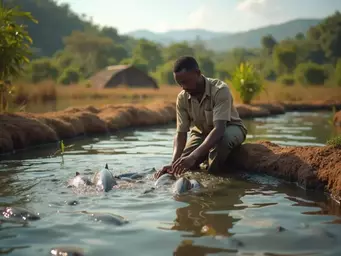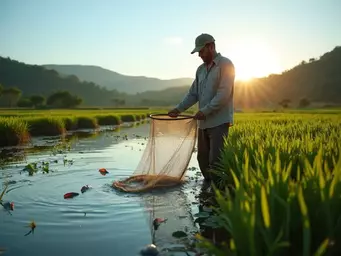Avoid These Fish Farming Mistakes
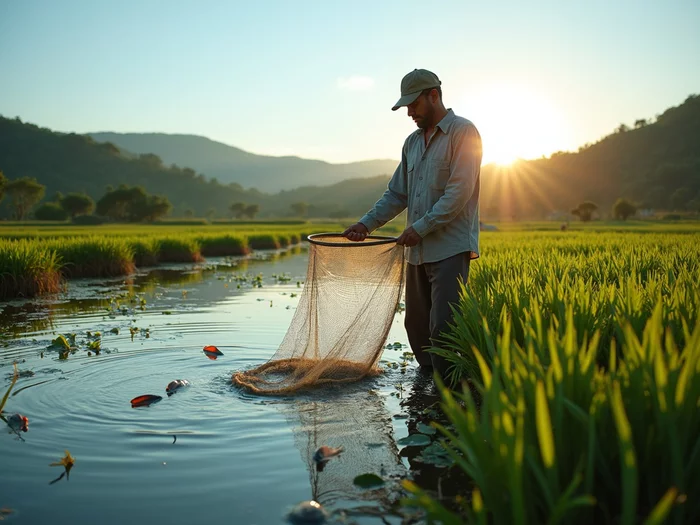
Posted on: 2025-08-29
By: Kwame Adom
Are you ready to transform your dreams into a thriving fish farming business? With the ever-increasing demand for sustainable seafood in Africa, now is the perfect time to dive into this rewarding industry. Let's explore key insights that can set you on the path to success!
What You Will Learn
- The fish farming industry in Africa is rapidly growing due to increased demand for sustainable protein sources.
- Sustainable practices and technological innovations are crucial for enhancing productivity while protecting the ecosystem.
- Fish farming significantly contributes to food security and local economic development by creating jobs and improving nutrition.
- Tilapia and catfish are the most profitable species for aquaculture in Africa, with unique market strengths.
- Aquaponics combines fish farming with plant cultivation, maximizing resource efficiency and opening new market opportunities.
- Continuous learning and adaptation are essential for success in the evolving aquaculture landscape.
- Community engagement and support can enhance productivity and empower future generations of farmers.
The Pillars of Sustainable Fish Farming
Success in African aquaculture hinges on understanding market dynamics and adopting sustainable practices. The visual below highlights the key species and methods driving growth in the sector.
Key Species in African Aquaculture
Tilapia: Fast growth, mild flavor, high marketability.
Catfish: Adaptable, staple in diets, steady demand.
Aquaponics: Sustainable Farming
Water Efficiency: Less water than traditional methods.
Organic Produce: Grow vegetables with fish.
Integrated System: Fish waste feeds plants.
Understanding the Landscape of Fish Farming in Africa
The fish farming industry in Africa is rapidly evolving, driven by the increasing demand for sustainable protein sources. This growth presents a unique opportunity for aspiring farmers like you to dive into a sector that not only feeds communities but also boosts local economies. Let's explore the nuances of aquaculture in Africa and how you can position yourself for success in this thriving market!
Overview of Aquaculture Growth in African Markets
Aquaculture has seen significant growth across various African nations in recent years. Countries like Nigeria, Ghana, Kenya, and South Africa are paving the way with innovative practices that cater to local markets. This is an exciting time for fish farming as we witness a shift towards more sustainable and profitable methods.
- Increased Demand: The demand for fish and seafood continues to rise due to population growth and dietary changes among consumers.
- Sustainable Practices: More farmers are adopting environmentally friendly practices that enhance productivity without compromising the ecosystem. For instance, the East Coast Shellfish Growers Association's Best Practices document outlines methods for responsible aquaculture, which can be adapted to various contexts.
- Technological Innovations: The introduction of modern farming techniques and technologies is revolutionizing the way fish farming is conducted.
As the industry expands, it’s crucial to stay informed about these trends. Understanding the growth dynamics will give you a competitive edge and help you make informed decisions as you embark on your fish farming journey.
The Role of Fish Farming in Food Security and Economic Development
Fish farming is not just about profit; it plays a vital role in ensuring food security and fostering economic development across the continent. By increasing local fish production, fish farming helps reduce reliance on imported seafood and enhances the nutritional intake of communities.
- Job Creation: Fish farming generates employment opportunities, contributing to local economies.
- Nutrition Improvement: Access to fresh fish is crucial for improving dietary health in many regions.
- Economic Resilience: Sustainable fish farming can make communities more resilient to economic fluctuations. The Fish and Aquatic Conservation Annual Report highlights efforts to support healthy aquatic ecosystems, which are fundamental to robust fish farming.
As you consider entering this field, remember that your efforts can significantly impact the well-being of your community while also creating a profitable business.
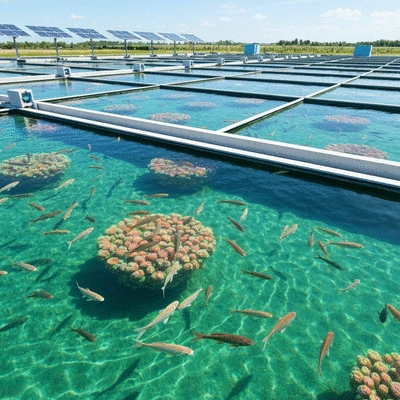
Key Species in African Aquaculture: Tilapia and Catfish
When it comes to selecting species for your fish farm, tilapia and catfish emerge as the top choices in African aquaculture. Both species are well-suited to various environmental conditions and have established markets that promise profitability.
Comparative Benefits of Tilapia and Catfish in Local Markets
Each species has its unique strengths that can cater to different market demands:
- Tilapia: Known for its mild flavor and fast growth rate, tilapia is a favorite among consumers, making it highly marketable.
- Catfish: With its adaptability to various farming conditions, catfish has become a staple in many African diets, ensuring steady demand.
By understanding these benefits, you can choose the species that aligns best with your resources, skills, and market needs.
Exploring Aquaponics as a Sustainable Farming Method
Aquaponics combines fish farming with plant cultivation, creating a symbiotic environment that maximizes resource efficiency. This method can be a game-changer for your fish farming business, promoting sustainability while diversifying income streams.
- Water Efficiency: Aquaponics uses significantly less water compared to traditional farming methods.
- Organic Produce: You can grow vegetables alongside fish, tapping into the organic market that is on the rise.
- Integrated System: The waste produced by fish acts as nutrients for plants, creating a closed-loop system that is both efficient and eco-friendly.
As you explore fish farming options, consider the benefits of integrating aquaponics into your business model. It not only enhances sustainability but also opens up new market opportunities!
Frequently Asked Questions About Fish Farming in Africa
What makes fish farming in Africa a promising venture?
The increasing demand for sustainable protein sources, combined with population growth and dietary changes, makes fish farming in Africa a rapidly growing and promising industry. It offers opportunities for food security, economic development, and job creation.
Which fish species are most profitable for aquaculture in Africa?
Tilapia and catfish are generally considered the most profitable species for aquaculture in Africa. Tilapia is favored for its fast growth and mild flavor, while catfish is highly adaptable and a staple in many local diets, ensuring steady demand.
What is aquaponics and how can it benefit a fish farming business?
Aquaponics is a sustainable farming method that combines fish farming with plant cultivation in a symbiotic system. It offers benefits such as high water efficiency, the ability to produce organic vegetables, and an integrated system where fish waste nourishes plants, diversifying income streams and promoting eco-friendliness.
Why is continuous learning important in aquaculture?
Aquaculture is an ever-evolving field. Continuous learning, through workshops, industry news, and experimenting with new techniques, is crucial for staying up-to-date with best practices, improving fish health, adapting to market trends, and enhancing overall profitability and sustainability.
How can community engagement support a fish farming business in Africa?
Community engagement, particularly promoting gender and youth involvement, can significantly benefit fish farming. It brings fresh ideas, fosters economic empowerment, and creates a supportive environment. Connecting with local fish farming associations provides invaluable resources, training, networking, and technical advice, contributing to shared success and resilience.
Pro Tip
Did you know? Engaging with local fish farming associations can provide essential resources and networking opportunities that will enhance your fish farming business. These associations often offer training programs, technical advice, and collective marketing strategies that can boost your profitability and sustainability.
Summarizing Key Takeaways for Aspiring Fish Farmers
As you embark on your journey in fish farming, it's crucial to grasp the strategic insights that can help you sidestep common pitfalls. Successfully navigating this venture involves understanding your market, maintaining high fish health standards, and consistently adapting to challenges. By recognizing these factors, you can position yourself for a thriving aquaculture business!
- Conduct thorough market research to understand local demand and competition.
- Prioritize training and skill development to enhance your technical expertise.
- Establish a solid financial plan to safeguard your investments.
- Engage with local resources and support networks to bolster your business.
Remember, avoiding these pitfalls isn't just about individual success; it contributes to the overall health of the fish farming community. Together, we can create a sustainable future!
The Importance of Continuous Learning and Adaptation in Aquaculture
The world of aquaculture is ever-evolving, and as aspiring fish farmers, it's essential to embrace a mindset of continuous learning. Staying informed about new techniques, species, and market trends can significantly enhance your operations. For instance, techniques like integrated pest management can help improve fish health and reduce the need for harmful chemicals. The 2023 NSTC Subcommittee on Aquaculture Research Plan Progress Report provides valuable insights into ongoing research and development in the field.
- Participate in training programs and workshops to stay up-to-date.
- Follow industry news and join online forums to connect with fellow farmers.
- Experiment with innovative farming techniques, such as aquaponics.
By committing to lifelong learning, you not only improve your skills but also contribute to the growth of the aquaculture sector across Africa. Let's keep pushing the boundaries of what's possible in fish farming!
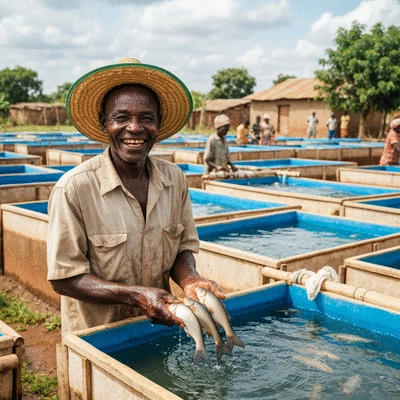
Encouraging Community Engagement and Support
Community is at the heart of successful fish farming. By fostering connections and encouraging involvement, we can create a supportive environment that benefits all. One of the key aspects to focus on is promoting gender and youth involvement in fish farming. This not only enhances productivity but also empowers a new generation of farmers!
Promoting Gender and Youth Involvement in Fish Farming
Involving women and young people in fish farming has substantial benefits. It brings fresh ideas and perspectives to the industry while also paving the way for economic empowerment. For example, women often play crucial roles in managing fish farms, bringing resilience and dedication that can drive success.
- Implement mentorship programs to guide youth entering the field.
- Highlight success stories of women in aquaculture to inspire others.
- Encourage joint ventures between experienced farmers and young entrepreneurs.
By embracing inclusivity, we can unlock the full potential of our communities and enrich the fish farming landscape.
Connecting with Local Resources and Support Networks
As you navigate the challenges of fish farming, it’s vital to connect with local resources and support networks. These connections can provide invaluable information, resources, and encouragement as you build your business. Engaging with established associations can help you stay informed and empowered!
The Importance of Fish Farming Associations in Community Development
Fish farming associations play a pivotal role in uplifting communities. They offer training, share research, and facilitate networking opportunities among farmers. By joining these associations, you can access resources that are tailored to your specific needs and local conditions.
- Attend local association meetings to meet fellow farmers and share experiences.
- Utilize resources offered by associations for technical and business advice.
- Participate in community initiatives aimed at improving aquaculture practices.
By working together, we can build a more resilient and supportive aquaculture community!
Taking the Next Steps in Your Fish Farming Journey
As you look to the future, it's essential to focus on the steps that will propel your fish farming business forward. Whether you are just starting or looking to scale your operations, having access to the right resources will make all the difference!
Resources for Further Learning and Development
There are numerous resources available for aspiring fish farmers. From online courses to local workshops, the options are plentiful. By investing in your education, you set the foundation for success in your aquaculture venture.
- Explore online platforms offering courses on fish farming and aquaculture.
- Seek mentorship from experienced farmers in your area.
- Attend agricultural fairs and expos to discover new techniques and tools.
These resources can help equip you with the knowledge you need to thrive in the fish farming industry!
Call to Action: Start Your Fish Farming Business with Confidence
Now is the time to take action! With the right strategies, knowledge, and community support, you can launch your fish farming business successfully. I believe that with determination and dedication, you can play a significant role in transforming Africa's aquaculture landscape!
Exploring Investment and Funding Opportunities for Startups
Understanding the available funding sources is crucial for your startup journey. Whether it's government grants, private investors, or crowdfunding, there are various options to explore.
- Research government programs that support agricultural enterprises.
- Connect with local banks that offer loans for fish farming operations.
- Look into crowdfunding platforms tailored for agricultural projects.
By proactively seeking out funding opportunities, you can secure the necessary capital to realize your fish farming dreams. Let’s take these next steps together, and I’m here to help guide you along the way!
Recap of Key Points
Here is a quick recap of the important points discussed in the article:
- Market Research: Conduct thorough research to understand local demand and competition in fish farming.
- Sustainable Practices: Embrace environmentally friendly farming techniques to enhance productivity and market appeal.
- Key Species: Focus on tilapia and catfish as primary species due to their market demand and adaptability.
- Aquaponics Integration: Consider integrating aquaponics for sustainable resource management and diversified income.
- Community Engagement: Promote gender and youth involvement in fish farming to empower local communities and drive innovation.
- Continuous Learning: Commit to lifelong learning through training programs, workshops, and industry news to adapt to evolving practices.
 The future of aquaculture in Africa is brimming with opportunities, driven by innovation and sustain
The future of aquaculture in Africa is brimming with opportunities, driven by innovation and sustain
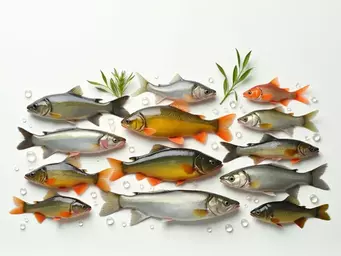 The increasing demand for fish protein in Africa is creating a wealth of opportunities for aspiring
The increasing demand for fish protein in Africa is creating a wealth of opportunities for aspiring
 As the demand for fish continues to rise, Ghana's aquaculture sector presents a wealth of opportunit
As the demand for fish continues to rise, Ghana's aquaculture sector presents a wealth of opportunit



